 The latest UK house price index continues to show an easing in the rate of house price inflation. In the year to January 2019 the average UK house price rose by 1.7 per cent, the lowest rate since June 2013 when it was 1.5 per cent. This is significantly below the recent peak in house price inflation when in May 2016 house prices were growing at 8.2 per cent year-on-year. In this blog we consider how recent patterns in UK house prices compare with those over the past 50 years and also how the growth of house prices compares to that in consumer prices.
The latest UK house price index continues to show an easing in the rate of house price inflation. In the year to January 2019 the average UK house price rose by 1.7 per cent, the lowest rate since June 2013 when it was 1.5 per cent. This is significantly below the recent peak in house price inflation when in May 2016 house prices were growing at 8.2 per cent year-on-year. In this blog we consider how recent patterns in UK house prices compare with those over the past 50 years and also how the growth of house prices compares to that in consumer prices.
The UK and its nations
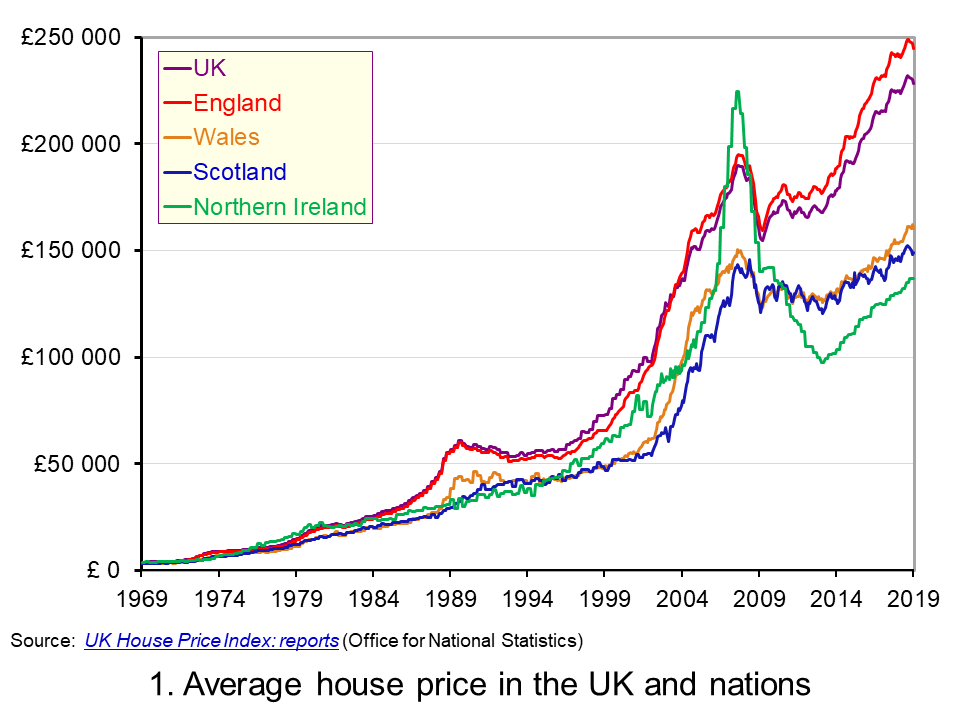 The average UK house price in January 2019 was £228,000. As Chart 1 shows, this masks considerable differences across the UK. In England the average price was £245,000 (an annual increase of 1.5 per cent), while in Scotland it was £149,000 (an increase of 1.3 per cent), Wales £160,000 (an increase of 4.6 per cent) and £137,000 in Northern Ireland (an increase of 5.5 per cent). (Click here to download a PowerPoint copy of the chart.)
The average UK house price in January 2019 was £228,000. As Chart 1 shows, this masks considerable differences across the UK. In England the average price was £245,000 (an annual increase of 1.5 per cent), while in Scotland it was £149,000 (an increase of 1.3 per cent), Wales £160,000 (an increase of 4.6 per cent) and £137,000 in Northern Ireland (an increase of 5.5 per cent). (Click here to download a PowerPoint copy of the chart.)
Within England there too are considerable differences in house prices, with London massively distorting the English average. In January 2019 the average house price in inner London was recorded at £568,000, a fall of 1.9 per cent on January 2018. In Outer London the average price was £426,000, a fall of 0.2 per cent. Across London as a whole the average price was £472,000, a fall of 1.6 per cent. House prices were lowest in the North East at £125,000, having experienced an annual increase of 0.9 per cent.
The Midlands can be used as a reference point for English house prices outside of the capital. In January 2019 the average house price in the West Midlands was £195,000 while in the East Midlands it was £193,000. While the annual rate of house price inflation in London is now negative, the annual rate of increase in the Midlands was the highest in England. In the West Midlands the annual increase was 4 per cent while in the East Midlands it was 4.4 per cent. These rates of increase are currently on par with those across Wales.
Long-term UK house price trends
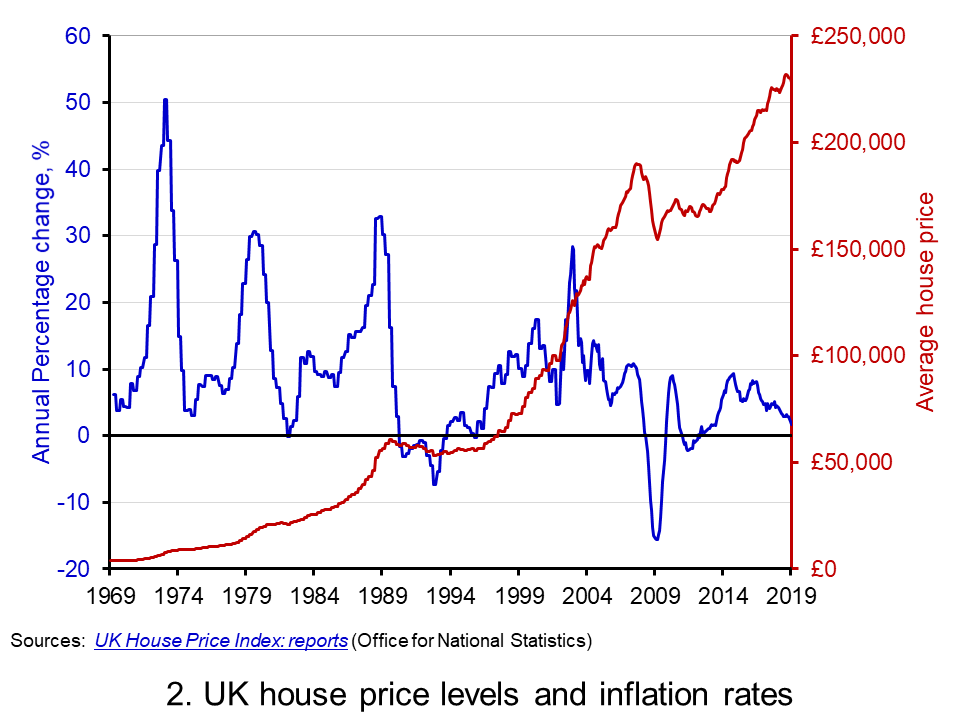 Chart 2 shows the average house price for the UK since 1969 alongside the annual rate of house price inflation, i.e. the annual percentage change in the level of house prices. The average UK house price in January 1969 was £3,750. By January 2019, as we have seen, it had risen to around £228,000. This is an increase of nearly 6,000 per cent. Over this period, the average annual rate of house price inflation was 9 per cent. However, if we measure it to the end of 2007 it was 11 per cent. (Click here to download a PowerPoint copy of the chart.)
Chart 2 shows the average house price for the UK since 1969 alongside the annual rate of house price inflation, i.e. the annual percentage change in the level of house prices. The average UK house price in January 1969 was £3,750. By January 2019, as we have seen, it had risen to around £228,000. This is an increase of nearly 6,000 per cent. Over this period, the average annual rate of house price inflation was 9 per cent. However, if we measure it to the end of 2007 it was 11 per cent. (Click here to download a PowerPoint copy of the chart.)
The significant effect of the financial crisis on UK house prices is evident from Charts 1 and 2. In February 2009 house prices nationally were 16 per cent lower than a year earlier. Furthermore, it was not until August 2014 that the average UK house rose above the level of September 2007. Indeed, some parts of the UK, such as Northern Ireland and the North East of England, remain below their pre-financial crisis level even today.
Nominal and real UK house prices
But how do house price patterns compare to those in consumer prices? In other words, what has happened to inflation-adjusted or real house prices? One index of general prices is the Retail Prices Index (RPI). This index measures the cost of a representative basket of consumer goods and services. Since January 1969 the RPI has increased by nearly 1,600 per cent. While substantial in its own right, it does mean that house prices have increased considerably more rapidly than consumer prices.
If we eliminate the increase in consumer prices from the actual (nominal) house price figures what is left is the increase in house prices relative to consumer prices. To do this we estimate house prices as if consumer prices had remained at their January 1987 level. This creates a series of average UK house prices at constant January 1987 consumer prices.
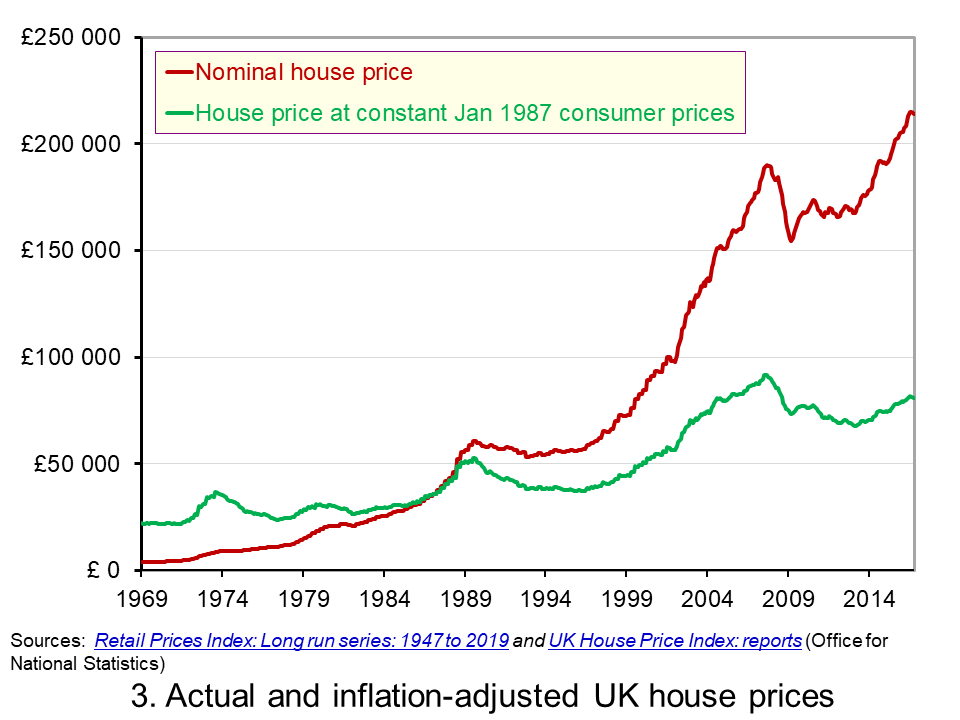 Chart 3 shows the average nominal and real UK house price since 1969. It shows that in real terms the average UK house price increased by around 266 per cent between January 1969 and January 2019. Therefore, the average real UK house price was 3.7 times more expensive in 2019 compared with 1969. This is important because it means that general price inflation cannot explain all the long-term growth seen in average house prices. (Click here to download a PowerPoint copy of the chart.)
Chart 3 shows the average nominal and real UK house price since 1969. It shows that in real terms the average UK house price increased by around 266 per cent between January 1969 and January 2019. Therefore, the average real UK house price was 3.7 times more expensive in 2019 compared with 1969. This is important because it means that general price inflation cannot explain all the long-term growth seen in average house prices. (Click here to download a PowerPoint copy of the chart.)
Real UK house price cycles
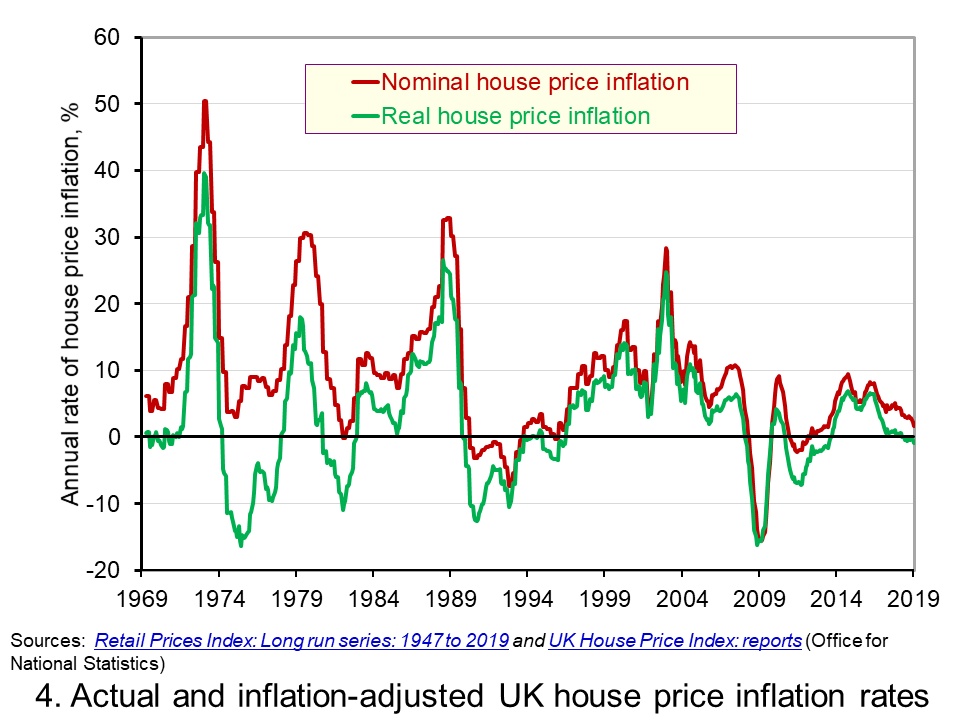 Chart 4 shows that annual rates of nominal and real house price inflation. As we saw earlier, the average nominal house price inflation rate since 1969 has been 9 per cent. The average real rate of increase in house prices has been 3.1 per cent per annum. In other words, house prices have on average each each year increased by the annual rate of RPI inflation plus 3.1 percentage points. (Click here to download a PowerPoint copy of the chart.)
Chart 4 shows that annual rates of nominal and real house price inflation. As we saw earlier, the average nominal house price inflation rate since 1969 has been 9 per cent. The average real rate of increase in house prices has been 3.1 per cent per annum. In other words, house prices have on average each each year increased by the annual rate of RPI inflation plus 3.1 percentage points. (Click here to download a PowerPoint copy of the chart.)
Chart 4 shows how, in addition to the long-term relative increase in house prices, there are also cycles in the relative price of houses. This is evidence of a volatility in house prices that cannot be explained by general prices. This volatility reflects frequent imbalances between the demand and supply of housing, i.e. between instructions to buy and sell property. Increasing levels of housing demand (instructions to buy) relative to housing supply (instructions to supply) will put upward pressure on house prices and vice versa.
In January 2019 the annual real house price inflation across the UK was -0.9 per cent. While the rate was slightly lower in Scotland at -1.2 per cent, the biggest drag on UK house price inflation was the London market where the real house price inflation rate was -4.0 per cent. In contrast, January saw annual real house price inflation rates of 2 per cent in Wales, 2.3 per cent in Northern Ireland and 1.8 per cent in the East Midlands.
Inflation-adjusted inflation rates in London have been negative consistently since June 2017. From their July 2016 peak, following the result of the referendum on UK membership of the EU, to January 2019 inflation-adjusted house prices fell by 7.6 per cent. This reflects, in part, the fact that the London housing market, like that of other European capitals, is a more international market than other parts of the country. Therefore, the current patterns in UK house prices are rather distinctive in that the easing is being led by London and southern England.
Articles
Questions
- What is meant by the annual rate of house price inflation?
- How is a rise in the rate of house price inflation different from a rise in the level of house prices?
- What factors are likely to determine housing demand (instructions to buy)?
- What factors are likely to affect housing supply (instructions to sell)?
- Explain the difference between nominal and real house prices.
- What does a decrease in real house prices mean? Can this occur even if actual house prices have risen?
- How might we explain the recent differences between house price inflation rates in London relative to other parts of the UK, like the Midlands and Wales?
- Why were house prices so affected by the financial crisis?
- Assume that you asked to measure the affordability of housing. What data might you collect?
 When making a decision, what happens if you do nothing: i.e. take no action? The answer is the default option. There is evidence that changing the default option for the same decision can sometimes have a big impact on the final choices people make. For example, when a person starts a new job, they often have to decide whether to contribute to the company’s pension scheme. The default option is typically for employees not to contribute. They have to do something actively (e.g. fill in an online form) to opt in to the scheme. An alternative is to change the default option so that employees are contributing to the pension. They now have to do something to opt out of the scheme.
When making a decision, what happens if you do nothing: i.e. take no action? The answer is the default option. There is evidence that changing the default option for the same decision can sometimes have a big impact on the final choices people make. For example, when a person starts a new job, they often have to decide whether to contribute to the company’s pension scheme. The default option is typically for employees not to contribute. They have to do something actively (e.g. fill in an online form) to opt in to the scheme. An alternative is to change the default option so that employees are contributing to the pension. They now have to do something to opt out of the scheme.
Changing the default should have no impact on people who behave in ways that are consistent with the rational choice model in economics. However, research by Madrian and Shea (2001) found that it had a big effect. When employees had to opt-in, 49 per cent enrolled in a company pension. When they had to opt out, the figure increased to 86 per cent.
Other research suggests that defaults can influence the likelihood of getting a flu jab, making healthier food choices, receiving e-mail marketing and choosing certain types of car insurance.
Organ donation
One policy area where the choice of default has become a topical issue is organ donation. In 2017, over 400 people died in the UK because it was impossible to find an appropriate donor. Could changing the default increase the number of donors?
The scheme that operates in England requires people to sign-up to the organ donor register: i.e. they have to opt in. Although 80 per cent of the public support organ donation less than 50 per cent ever get around to signing this register.
Parliament recently approved the Organ Donation Bill and the new law will come into effect in 2020. The default position will change so that people are automatically signed-up for organ donation. If they do not want to donate their organs, they will have to opt out of the register.
In December 2015, the devolved Welsh government introduced a similar scheme. Although it is quite early to give a full assessment of the policy, its impact has been smaller than many people had hoped.
Why have the initial results been disappointing? One potential downside with an opt-out scheme is that it may create greater uncertainty about someone’s true wishes. With an opt-in scheme, a relative takes a deliberate action to indicate their preference to be an organ donor. In England, approximately 10 per cent of families overrule the wishes of a relative who has actively signed the register.
With an opt-out scheme, family members may worry that their relative did not want to donate their organs but never found the time to take their name off the register. In 2017/18, families in Wales overruled the presumed consent of their relatives in 33 per cent of cases.
Some countries, such as Singapore and Austria, operate a ‘hard opt-out’ policy. In these schemes, families cannot overrule and this leads to high organ donor rates. However, this type of policy is unpopular with large sections of the electorate who feel it is over paternalistic.
Forcing people to make a choice
Is it possible to force people to make a choice and so reveal their preferences to others? This is a policy of active choice. For example, the government could make the issuing of a driving licence conditional on a people making a choice about whether or not to sign the organ donor register.
 This type of policy has been trialled in the USA with the take up of home delivered prescriptions. For the majority of people, there are clear advantages of choosing to have home delivered prescriptions rather than visiting a pharmacy – it is both cheaper and involves less time/hassle. However, the default option is to visit a pharmacy and one study found that only 6 per cent of people chose home delivered options. With the introduction of active choice, this figure increased to 42 per cent.
This type of policy has been trialled in the USA with the take up of home delivered prescriptions. For the majority of people, there are clear advantages of choosing to have home delivered prescriptions rather than visiting a pharmacy – it is both cheaper and involves less time/hassle. However, the default option is to visit a pharmacy and one study found that only 6 per cent of people chose home delivered options. With the introduction of active choice, this figure increased to 42 per cent.
Some have argued that it is socially undesirable to force people to make a choice. An alternative is simplified active choice – people can either make a choice or accept the default option.
Articles
Questions
- Explain why changing the default option should have no impact on people who behave in ways that are consistent with the rational choice model in economics.
- What is present bias? How does it differ from simple impatience? Explain how present bias might help to explain the impact of changing the default option.
- What is loss aversion? How does it differ from diminishing marginal utility? Explain how loss aversion might help to explain the impact of changing the default option.
- What are some of the limitations of using defaults in policy-making?
- Is active choice less paternalistic than changing the default option?
- Think of some reasons why someone may not want to make a choice.
 Consumer credit is borrowing by individuals to finance current expenditure on goods and services. Consumer credit is distinct from lending secured on dwellings (referred to more simply as ‘secured lending’). Consumer credit comprises lending on credit cards, lending through overdraft facilities and other loans and advances, for example those financing the purchase of cars. We consider here recent trends in the flows of consumer credit in the UK and discuss their implications.
Consumer credit is borrowing by individuals to finance current expenditure on goods and services. Consumer credit is distinct from lending secured on dwellings (referred to more simply as ‘secured lending’). Consumer credit comprises lending on credit cards, lending through overdraft facilities and other loans and advances, for example those financing the purchase of cars. We consider here recent trends in the flows of consumer credit in the UK and discuss their implications.
Analysing consumer credit data is important because the growth of consumer credit has implications for the financial wellbeing or financial health of individuals and, of course, for financial institutions. As we shall see shortly, the data on consumer credit is consistent with the existence of credit cycles. Cycles in consumer credit have the potential to be not only financially harmful but economically destabilising. After all, consumer credit is lending to finance spending and therefore the amount of lending can have significant effects on aggregate demand and economic activity.
Data on consumer credit are available monthly and so provide an early indication of movements in economic activity. Furthermore, because lending flows are likely to be sensitive to changes in the confidence of both borrowers and lenders, changes in the growth of consumer credit can indicate turning points in the economy and, hence, in the macroeconomic environment.
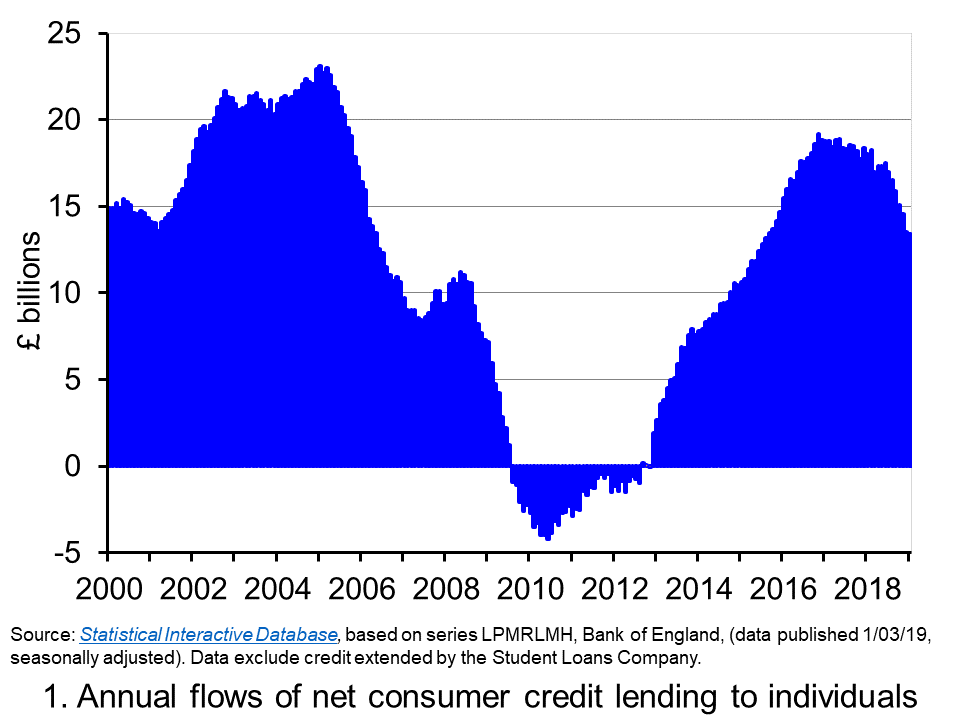 Chart 1 shows the annual flows of net consumer credit since 2000 – the figures are in £ billions. Net flows are gross flows less repayments. (Click here to download a PowerPoint copy of the chart.) In January 2005 the annual flow of net consumer credit peaked at £23 billion, the equivalent of just over 2.5 per cent of annual disposable income. This helped to fuel spending and by the final quarter of the year, the economy’s annual growth rate had reached 4.8 per cent, significantly about its long-run average of 2.5 per cent.
Chart 1 shows the annual flows of net consumer credit since 2000 – the figures are in £ billions. Net flows are gross flows less repayments. (Click here to download a PowerPoint copy of the chart.) In January 2005 the annual flow of net consumer credit peaked at £23 billion, the equivalent of just over 2.5 per cent of annual disposable income. This helped to fuel spending and by the final quarter of the year, the economy’s annual growth rate had reached 4.8 per cent, significantly about its long-run average of 2.5 per cent.
By 2009 net consumer credit flows had become negative. This meant that repayments were greater than additional flows of credit. It was not until 2012 that the annual flow of net consumer credit was again positive. Yet by November 2016, the annual flow of net consumer credit had rebounded to over £19 billion, the equivalent of just shy of 1.5 per cent of annual disposable income. This was the largest annual flow of consumer credit since September 2005.
Although the strength of consumer credit in 2016 was providing the economy with a timely boost to growth in the immediate aftermath of the referendum on the UK’s membership of the EU, it nonetheless raised concerns about its sustainability. Specifically, given the short amount of time that had elapsed since the financial crisis and the extreme levels of financial distress that had been experienced by many sectors of the economy, how susceptible would people and organisations be to a future economic slowdown and/or rise in interest rates?
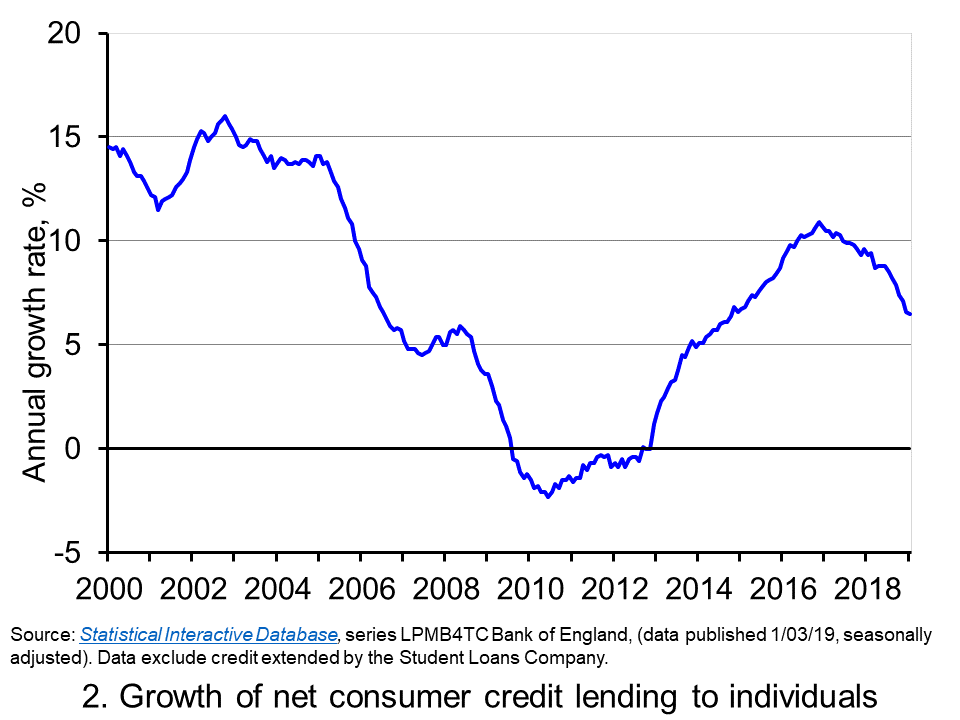 The extent to which the economy experiences consumer credit cycles can be seen even more readily by looking at the 12-month growth rate in the net consumer credit. In essence, this mirrors the growth rate in the stock of consumer credit. Chart 2 evidences the double-digit growth rates in net consumer credit lending experienced during the first half of the 2000s. Growth rates then eased but, as the financial crisis unfolded, they plunged sharply. (Click here to download a PowerPoint copy of the chart.)
The extent to which the economy experiences consumer credit cycles can be seen even more readily by looking at the 12-month growth rate in the net consumer credit. In essence, this mirrors the growth rate in the stock of consumer credit. Chart 2 evidences the double-digit growth rates in net consumer credit lending experienced during the first half of the 2000s. Growth rates then eased but, as the financial crisis unfolded, they plunged sharply. (Click here to download a PowerPoint copy of the chart.)
Yet, as Chart 2 shows, consumer credit growth began to recover quickly from 2013 so that by 2016 the annual growth rate of net consumer credit was again in double figures. In November 2016 the 12-month growth rate of net consumer credit peaked at 10.9 per cent. Thereafter, the growth rate has continually eased. In January 2019 the annual growth rate of net consumer credit had fallen back to 6.5 per cent, the lowest rate since October 2014.
The easing of consumer credit is likely to have been influenced, in part, by the resumption in the growth of real earnings from 2018 (see Getting real with pay). Yet, it is hard to look past the economic uncertainties around Brexit.
Uncertainty tends to cause people to be more cautious. With the heightened uncertainty that has has characterised recent times, it is likely that for many people and businesses prudence has dominated impatience. Therefore, in summary, it appears that prudence is helping to steer borrowing along a downswing in the credit cycle. As it does, it helps to put a further brake on spending and economic growth.
Articles
Questions
- What is the difference between gross and net lending?
- Consider the argument that we should be worried more by excessive growth in consumer credit than on lending secured on dwellings?
- How could we measure whether different sectors of the economy had become financially distressed?
- What might explain why an economy experiences credit cycles?
- Explain how the growth in net consumer credit can affect economic activity?
- If people are consumption smoothers, how can credit cycles arise?
- What are the potential policy implications of credit cycles?
- It is said that when making financial decisions people face an inter-temporal choice. Explain what you understand this by this concept.
- If economic uncertainty is perceived to have increased how could this affect the consumption, saving and borrowing decisions of people?
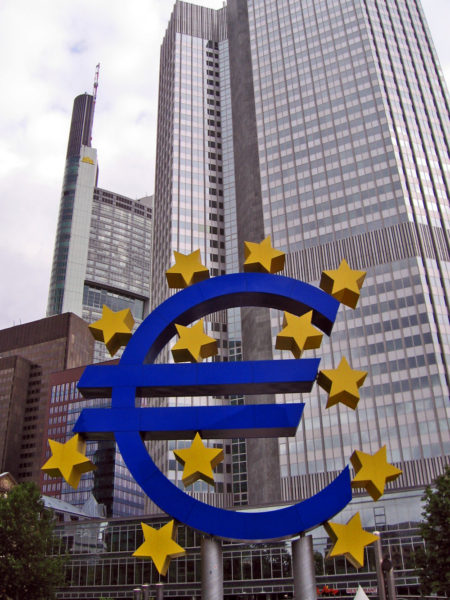 Growth in the eurozone has slowed. The European Central Bank (ECB) now expects it to be 1.1% this year; in December, it had forecast a rate of 1.7% for 2019. Mario Draghi, president of the ECB, in his press conference, said that ‘the weakening in economic data points to a sizeable moderation in the pace of the economic expansion that will extend into the current year’. Faced with a slowing eurozone economy, the ECB has announced further measures to stimulate economic growth.
Growth in the eurozone has slowed. The European Central Bank (ECB) now expects it to be 1.1% this year; in December, it had forecast a rate of 1.7% for 2019. Mario Draghi, president of the ECB, in his press conference, said that ‘the weakening in economic data points to a sizeable moderation in the pace of the economic expansion that will extend into the current year’. Faced with a slowing eurozone economy, the ECB has announced further measures to stimulate economic growth.
First it has indicated that interest rates will not rise until next year at the earliest ‘and in any case for as long as necessary to ensure the continued sustained convergence of inflation to levels that are below, but close to, 2% over the medium term’. The ECB currently expects HIPC inflation to be 1.2% in 2019. It was expected to raise interest rates later this year – probably by the end of the summer. The ECB’s main refinancing interest rate, at which it provides liquidity to banks, has been zero since March 2016, and so there was no scope for lowering it.
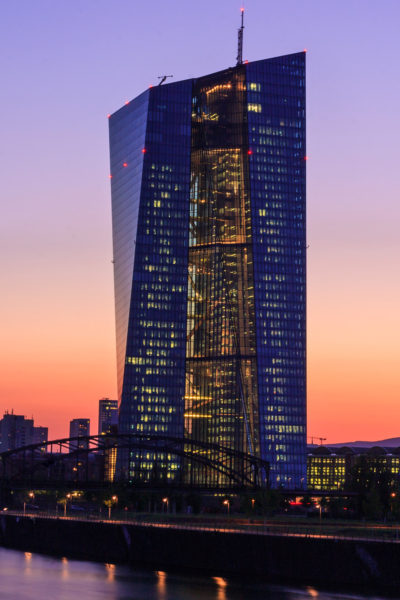 Second, although quantitative easing (the asset purchase programme) is coming to an end, there will be no ‘quantitative tightening’. Instead, the ECB will purchase additional assets to replace any assets that mature, thereby leaving the stock of assets held the same. This would continue ‘for an extended period of time past the date when we start raising the key ECB interest rates, and in any case for as long as necessary to maintain favourable liquidity conditions and an ample degree of monetary accommodation’.
Second, although quantitative easing (the asset purchase programme) is coming to an end, there will be no ‘quantitative tightening’. Instead, the ECB will purchase additional assets to replace any assets that mature, thereby leaving the stock of assets held the same. This would continue ‘for an extended period of time past the date when we start raising the key ECB interest rates, and in any case for as long as necessary to maintain favourable liquidity conditions and an ample degree of monetary accommodation’.
Third, the ECB is launching a new series of ‘quarterly targeted longer-term refinancing operations (TLTRO-III), starting in September 2019 and ending in March 2021, each with a maturity of two years’. These are low-interest loans to banks in the eurozone for use for specific lending to businesses and households (other than for mortgages) at below-market rates. Banks will be able to borrow up to 30% of their eligible assets (yet to be fully defined). These, as their acronym suggests, are the third round of such loans. The second round was relatively successful. As the Barron’s article linked below states:
Banks boosted their long-term borrowing from the ECB by 70% over the course of the program, although they did not manage to increase their holdings of business loans until after TLTRO II had finished disbursing funds in March 2017.
Whether these measures will be enough to raise growth rates in the eurozone depends on a range of external factors affecting aggregate demand. Draghi identified three factors which could have a negative effect.
- Brexit. The forecasts assume an orderly Brexit in accordance with the withdrawal deal agreed between the European Commission and the UK government. With the House of Commons having rejected this deal twice, even though it has agreed that there should not be a ‘no-deal Brexit’, this might happen as it is the legal default position. This could have a negative effect on the eurozone economy (as well as a significant one on the UK economy). Even an extension of Article 50 could create uncertainty, which would also have a negative effect
- Trade wars. If President Trump persists with his protectionist policy, this will have a negative effect on growth in the eurozone and elsewhere.
- China. Chinese growth has slowed and this dampens global growth. What is more, China is a major trading partner of the eurozone countries and hence slowing Chinese growth impacts on the eurozone through the international trade multiplier. The ECB has taken this into account, but if Chinese growth slows more than anticipated, this will further push down eurozone growth.
Then there are internal uncertainties in the eurozone, such as the political and economic uncertainty in Italy, which in December 2018 entered a recession (2 quarters of negative economic growth). Its budget deficit is rising and this is creating conflict with the European Commission. Also, there are likely to be growing tensions within Italy as the government raises taxes.
Faced with these and other uncertainties, the measures announced by Mario Draghi may turn out not to be enough. Perhaps in a few months’ there may have to be a further round of quantitative easing.
Articles
- ECB statement following policy meeting
Reuters, Larry King (7/3/19)
- European Central Bank acts to boost struggling eurozone
BBC News, Andrew Walker (7/3/19)
- The European Central Bank Tries to Avoid Repeating Past Mistakes
Barron’s, Matthew C. Klein (8/3/19)
- ECB pushes back rate hike plans, announces fresh funding for banks
CNBC, Silvia Amaro (7/3/19)
- Why the ECB Followed the Fed’s Flip-Flopping
Bloomberg, Mohamed A. El-Erian (7/3/19)
- Central Banks Don’t Have the Answer and Markets Know It
Bloomberg, Robert Burgess (7/3/19)
- Missing out on monetary normalisation
OMFIF, David Marsh (12/4/19)
- The ECB is attempting to get ahead of event
Financial Times, The editorial board (8/3/19)
- Explainer: What is the fuss about European Central Bank TLTRO loans?
Reuters, Balazs Koranyi (4/3/19)
Videos
ECB publications
Questions
- Investigate the history of quantitative easing and its use by the Fed, the Bank of England and the ECB. What is the current position of the three central banks on ‘quantitative tightening’, whereby central banks sell some of the stock of assets they have purchased during the process of quantitative easing or not replace them when they mature?
- What are TLTROs and what use of them has been made by the ECB? Do they involve the creation of new money?
- What will determine the success of the proposed TLTRO III scheme?
- If the remit of central banks is to keep inflation on target, which in the ECB’s case means below 2% HIPC inflation but close to it over the medium term, why do people talk about central banks using monetary policy to revive a flagging economy?
- What is ‘forward guidance’ by central banks and what determines its affect on aggregate demand?
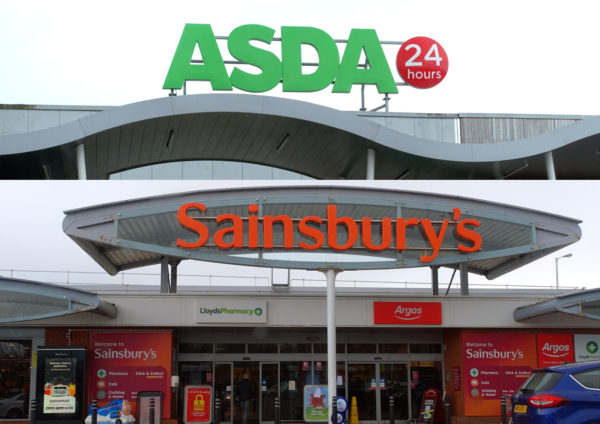 The ‘Big 4’ supermarkets in the UK – Tesco, Sainsbury’s, Asda and Morrisons – have a 69.5% share of the Great Britain grocery market (see data link below). The next four – Aldi, Co-op, Lidl and Waitrose – have a 23.8% share. If two of the Big 4 were to merge, would there be a significant decline in competition? This is a question the Competition and Markets Authority (CMA) has been considering in the light of Sainsbury’s planned £7.3 billion takeover of Asda (owned by the US retailing giant, Walmart).
The ‘Big 4’ supermarkets in the UK – Tesco, Sainsbury’s, Asda and Morrisons – have a 69.5% share of the Great Britain grocery market (see data link below). The next four – Aldi, Co-op, Lidl and Waitrose – have a 23.8% share. If two of the Big 4 were to merge, would there be a significant decline in competition? This is a question the Competition and Markets Authority (CMA) has been considering in the light of Sainsbury’s planned £7.3 billion takeover of Asda (owned by the US retailing giant, Walmart).
In a recently published provisional report, the CMA argues that “the merger could lead to a substantial lessening of competition at both a national and local level.” The CMA has concerns that the merger:
…could lead to a worse experience for in-store and online shoppers across the UK through higher prices, a poorer shopping experience, and reductions in the range and quality of products offered. It also has concerns that prices could rise at a large number of Sainsbury’s and Asda petrol stations. …The combined impact means that people could lose out right across the UK and that the deal could also cost shoppers through reduced competition in particular areas where Sainsbury’s and Asda stores overlap.
Sainsbury’s and Asda currently have a combined market share of 31.2%. This is slightly larger than Tesco’s 27.7%. But would this give the merged companies too much market power? Would there not still be intense competition between the new Big 3? 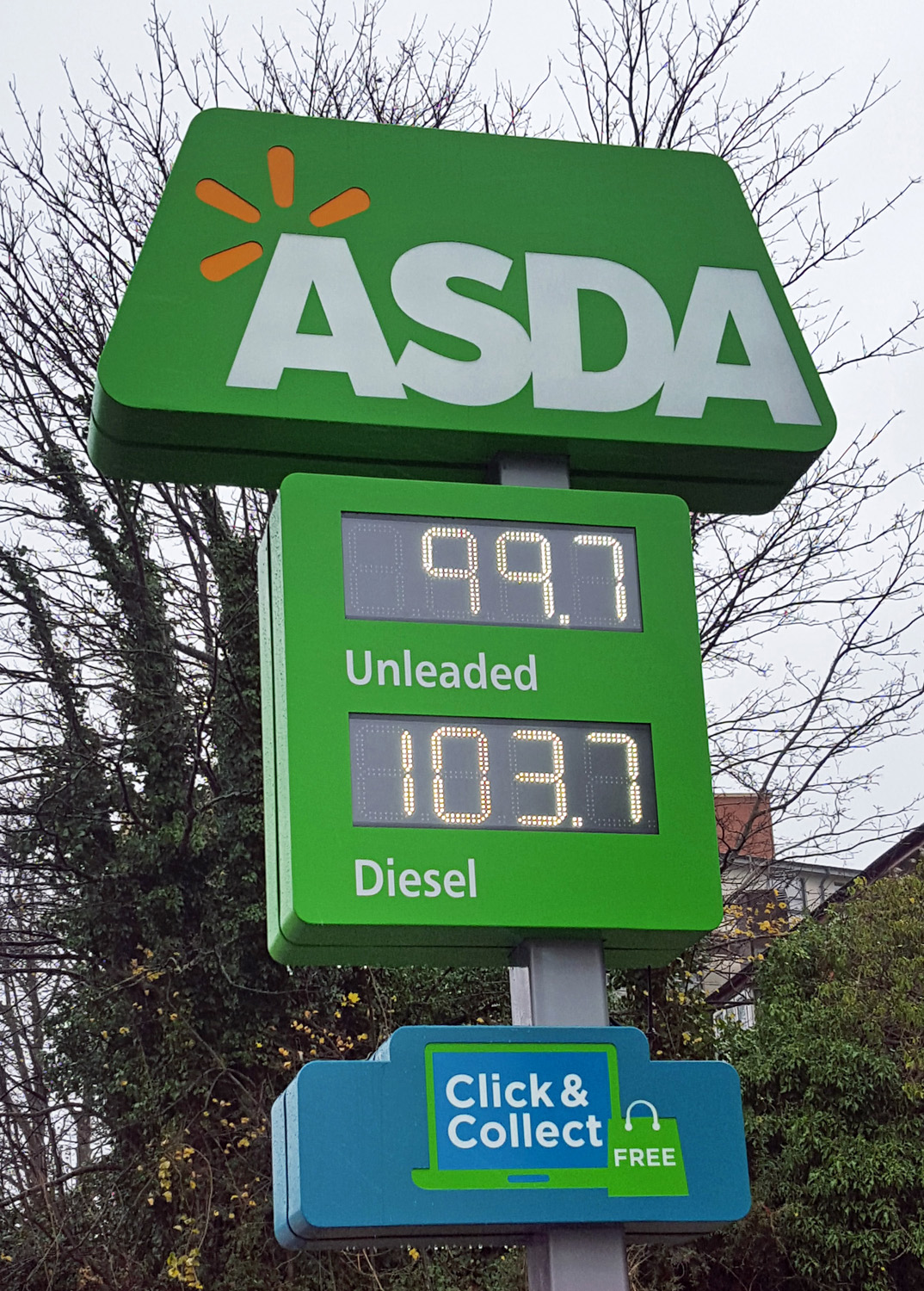 And, with the growth in the German discounters, Aldi and Lidl, as well as competition from Waitrose, the Co-op, Marks & Spencer and Iceland, would there be any significant decline in competition and choice and a rise in prices?
And, with the growth in the German discounters, Aldi and Lidl, as well as competition from Waitrose, the Co-op, Marks & Spencer and Iceland, would there be any significant decline in competition and choice and a rise in prices?
To answer this, it is crucial to define the grocery market. The CMA argues that the major competitors to any Big 4 company are the other Big 4 companies, rather than the German discounters or other supermarkets. Unlike Aldi and Lidl, the Big 4 have a range of facilities, such as fish and meat counters, delivery and a large range of branded products.
At a national level the CMA finds that the merger would reduce competitive pressure, so that a Big 3 would be less competitive than the Big 4, with higher prices and with reduced quality, range of products and in-store services.
At the local level the effects are likely to be serious. Often the consumer has very limited choice of supermarkets at a local level. If a particular area has just two supermarkets, Sainsbury’s and Asda, then the merger of the two could result in a substantial loss of competition. The only alternative for consumers in such areas would be to use small shops, which tend to be more highly priced anyway and do not compete head-to-head with the supermarkets, or to drive to another area or to shop online, depending on how far rival supermarkets are prepared to deliver. Similar arguments apply to supermarket petrol stations, where the only competition to supermarkets is from roadside petrol stations, often selling more highly priced petrol.
 In response to the CMA’s findings, Sainsbury’s chief executive, Mike Coupe, claims that they focus too much on competition between the Big 4 and do not take into account competition from Lidl and Aldi, both of which are expending rapidly and now have a combined market share of 12.8% (compared with 10.7% two years ago).
In response to the CMA’s findings, Sainsbury’s chief executive, Mike Coupe, claims that they focus too much on competition between the Big 4 and do not take into account competition from Lidl and Aldi, both of which are expending rapidly and now have a combined market share of 12.8% (compared with 10.7% two years ago).
Sainsbury’s and Asda also claim that there would be considerable scope for economies of scale, with lower costs being achieved through purchasing and logistics. In a joint statement they state that:
Combining Sainsbury’s and Asda would create significant cost savings, which would allow us to lower prices. Despite the savings being independently reviewed by two separate industry specialists, the CMA has chosen to discount them as benefits.
The two companies and other interested parties have until 13 March to respond to the provisional findings. The CMA will then issue its final report by 30 April 2019. If it sticks to its provisional findings, then either the merger will be blocked or the merging companies would have to ‘sell off a significant number of stores and other assets – potentially including one of the Sainsbury’s or Asda brands – to recreate the competitive rivalry lost through the merger.’ This might be very difficult to achieve as the new buyer would have to be big enough to provide effective competition to the remaining Big 3. Perhaps this could be an opportunity for Amazon to move into in-store grocery retailing. Or there may be some private equity company that would like to do the same.
It is likely that if the CMA sticks to its ruling, the two supermarkets will apply for a judicial review of the CMA’s decision.
Articles
Competition and Markets Authority Report
Data
Questions
- In what market segments do the Big 4 supermarkets compete?
- Research earlier investigations of the supermarket sector by the UK competition authorities. What were their findings?
- In what ways might the proposed takeover of Asda by Sainsbury’s affect consumers’ interests (a) at a national level; (b) at the local level?
- What is the ‘GUPPI index’? How is it calculated and how is it used in assessing the effects of the proposed takeover? (See pages 88–91 and 109–11 of the CMA’s Provisional Report and pages I5–I15 of the Appendices and Glossary.)
- Distinguish between horizontal and vertical mergers. How is the distinction relevant in drawing lessons from the Tesco takeover of Booker for the Sainsbury’s takeover of Asda?
- Rather than blocking the takeover, one alternative would be for the CMA to permit it, subject to the sale of specific stores where there are problems of the merger limiting competition in a particular locality. Do you think that this would be a better alternative than blocking the takeover? Explain.
 The latest UK house price index continues to show an easing in the rate of house price inflation. In the year to January 2019 the average UK house price rose by 1.7 per cent, the lowest rate since June 2013 when it was 1.5 per cent. This is significantly below the recent peak in house price inflation when in May 2016 house prices were growing at 8.2 per cent year-on-year. In this blog we consider how recent patterns in UK house prices compare with those over the past 50 years and also how the growth of house prices compares to that in consumer prices.
The latest UK house price index continues to show an easing in the rate of house price inflation. In the year to January 2019 the average UK house price rose by 1.7 per cent, the lowest rate since June 2013 when it was 1.5 per cent. This is significantly below the recent peak in house price inflation when in May 2016 house prices were growing at 8.2 per cent year-on-year. In this blog we consider how recent patterns in UK house prices compare with those over the past 50 years and also how the growth of house prices compares to that in consumer prices. The average UK house price in January 2019 was £228,000. As Chart 1 shows, this masks considerable differences across the UK. In England the average price was £245,000 (an annual increase of 1.5 per cent), while in Scotland it was £149,000 (an increase of 1.3 per cent), Wales £160,000 (an increase of 4.6 per cent) and £137,000 in Northern Ireland (an increase of 5.5 per cent). (Click here to download a PowerPoint copy of the chart.)
The average UK house price in January 2019 was £228,000. As Chart 1 shows, this masks considerable differences across the UK. In England the average price was £245,000 (an annual increase of 1.5 per cent), while in Scotland it was £149,000 (an increase of 1.3 per cent), Wales £160,000 (an increase of 4.6 per cent) and £137,000 in Northern Ireland (an increase of 5.5 per cent). (Click here to download a PowerPoint copy of the chart.) Chart 2 shows the average house price for the UK since 1969 alongside the annual rate of house price inflation, i.e. the annual percentage change in the level of house prices. The average UK house price in January 1969 was £3,750. By January 2019, as we have seen, it had risen to around £228,000. This is an increase of nearly 6,000 per cent. Over this period, the average annual rate of house price inflation was 9 per cent. However, if we measure it to the end of 2007 it was 11 per cent. (Click here to download a PowerPoint copy of the chart.)
Chart 2 shows the average house price for the UK since 1969 alongside the annual rate of house price inflation, i.e. the annual percentage change in the level of house prices. The average UK house price in January 1969 was £3,750. By January 2019, as we have seen, it had risen to around £228,000. This is an increase of nearly 6,000 per cent. Over this period, the average annual rate of house price inflation was 9 per cent. However, if we measure it to the end of 2007 it was 11 per cent. (Click here to download a PowerPoint copy of the chart.) Chart 3 shows the average nominal and real UK house price since 1969. It shows that in real terms the average UK house price increased by around 266 per cent between January 1969 and January 2019. Therefore, the average real UK house price was 3.7 times more expensive in 2019 compared with 1969. This is important because it means that general price inflation cannot explain all the long-term growth seen in average house prices. (Click here to download a PowerPoint copy of the chart.)
Chart 3 shows the average nominal and real UK house price since 1969. It shows that in real terms the average UK house price increased by around 266 per cent between January 1969 and January 2019. Therefore, the average real UK house price was 3.7 times more expensive in 2019 compared with 1969. This is important because it means that general price inflation cannot explain all the long-term growth seen in average house prices. (Click here to download a PowerPoint copy of the chart.) Chart 4 shows that annual rates of nominal and real house price inflation. As we saw earlier, the average nominal house price inflation rate since 1969 has been 9 per cent. The average real rate of increase in house prices has been 3.1 per cent per annum. In other words, house prices have on average each each year increased by the annual rate of RPI inflation plus 3.1 percentage points. (Click here to download a PowerPoint copy of the chart.)
Chart 4 shows that annual rates of nominal and real house price inflation. As we saw earlier, the average nominal house price inflation rate since 1969 has been 9 per cent. The average real rate of increase in house prices has been 3.1 per cent per annum. In other words, house prices have on average each each year increased by the annual rate of RPI inflation plus 3.1 percentage points. (Click here to download a PowerPoint copy of the chart.)



 When making a decision, what happens if you do nothing: i.e. take no action? The answer is the default option. There is evidence that changing the default option for the same decision can sometimes have a big impact on the final choices people make. For example, when a person starts a new job, they often have to decide whether to contribute to the company’s pension scheme. The default option is typically for employees not to contribute. They have to do something actively (e.g. fill in an online form) to opt in to the scheme. An alternative is to change the default option so that employees are contributing to the pension. They now have to do something to opt out of the scheme.
When making a decision, what happens if you do nothing: i.e. take no action? The answer is the default option. There is evidence that changing the default option for the same decision can sometimes have a big impact on the final choices people make. For example, when a person starts a new job, they often have to decide whether to contribute to the company’s pension scheme. The default option is typically for employees not to contribute. They have to do something actively (e.g. fill in an online form) to opt in to the scheme. An alternative is to change the default option so that employees are contributing to the pension. They now have to do something to opt out of the scheme. This type of policy has been trialled in the USA with the take up of home delivered prescriptions. For the majority of people, there are clear advantages of choosing to have home delivered prescriptions rather than visiting a pharmacy – it is both cheaper and involves less time/hassle. However, the default option is to visit a pharmacy and one study found that only 6 per cent of people chose home delivered options. With the introduction of active choice, this figure increased to 42 per cent.
This type of policy has been trialled in the USA with the take up of home delivered prescriptions. For the majority of people, there are clear advantages of choosing to have home delivered prescriptions rather than visiting a pharmacy – it is both cheaper and involves less time/hassle. However, the default option is to visit a pharmacy and one study found that only 6 per cent of people chose home delivered options. With the introduction of active choice, this figure increased to 42 per cent. Consumer credit is borrowing by individuals to finance current expenditure on goods and services. Consumer credit is distinct from lending secured on dwellings (referred to more simply as ‘secured lending’). Consumer credit comprises lending on credit cards, lending through overdraft facilities and other loans and advances, for example those financing the purchase of cars. We consider here recent trends in the flows of consumer credit in the UK and discuss their implications.
Consumer credit is borrowing by individuals to finance current expenditure on goods and services. Consumer credit is distinct from lending secured on dwellings (referred to more simply as ‘secured lending’). Consumer credit comprises lending on credit cards, lending through overdraft facilities and other loans and advances, for example those financing the purchase of cars. We consider here recent trends in the flows of consumer credit in the UK and discuss their implications. Chart 1 shows the annual flows of net consumer credit since 2000 – the figures are in £ billions. Net flows are gross flows less repayments. (Click
Chart 1 shows the annual flows of net consumer credit since 2000 – the figures are in £ billions. Net flows are gross flows less repayments. (Click  The extent to which the economy experiences consumer credit cycles can be seen even more readily by looking at the 12-month growth rate in the net consumer credit. In essence, this mirrors the growth rate in the stock of consumer credit. Chart 2 evidences the double-digit growth rates in net consumer credit lending experienced during the first half of the 2000s. Growth rates then eased but, as the financial crisis unfolded, they plunged sharply. (Click
The extent to which the economy experiences consumer credit cycles can be seen even more readily by looking at the 12-month growth rate in the net consumer credit. In essence, this mirrors the growth rate in the stock of consumer credit. Chart 2 evidences the double-digit growth rates in net consumer credit lending experienced during the first half of the 2000s. Growth rates then eased but, as the financial crisis unfolded, they plunged sharply. (Click  Growth in the eurozone has slowed. The European Central Bank (ECB) now expects it to be 1.1% this year; in December, it had forecast a rate of 1.7% for 2019. Mario Draghi, president of the ECB, in his
Growth in the eurozone has slowed. The European Central Bank (ECB) now expects it to be 1.1% this year; in December, it had forecast a rate of 1.7% for 2019. Mario Draghi, president of the ECB, in his  Second, although quantitative easing (the asset purchase programme) is coming to an end, there will be no ‘quantitative tightening’. Instead, the ECB will purchase additional assets to replace any assets that mature, thereby leaving the stock of assets held the same. This would continue ‘for an extended period of time past the date when we start raising the key ECB interest rates, and in any case for as long as necessary to maintain favourable liquidity conditions and an ample degree of monetary accommodation’.
Second, although quantitative easing (the asset purchase programme) is coming to an end, there will be no ‘quantitative tightening’. Instead, the ECB will purchase additional assets to replace any assets that mature, thereby leaving the stock of assets held the same. This would continue ‘for an extended period of time past the date when we start raising the key ECB interest rates, and in any case for as long as necessary to maintain favourable liquidity conditions and an ample degree of monetary accommodation’.
 The ‘Big 4’ supermarkets in the UK – Tesco, Sainsbury’s, Asda and Morrisons – have a 69.5% share of the Great Britain grocery market (see data link below). The next four – Aldi, Co-op, Lidl and Waitrose – have a 23.8% share. If two of the Big 4 were to merge, would there be a significant decline in competition? This is a question the Competition and Markets Authority (CMA)
The ‘Big 4’ supermarkets in the UK – Tesco, Sainsbury’s, Asda and Morrisons – have a 69.5% share of the Great Britain grocery market (see data link below). The next four – Aldi, Co-op, Lidl and Waitrose – have a 23.8% share. If two of the Big 4 were to merge, would there be a significant decline in competition? This is a question the Competition and Markets Authority (CMA)  And, with the growth in the German discounters, Aldi and Lidl, as well as competition from Waitrose, the Co-op, Marks & Spencer and Iceland, would there be any significant decline in competition and choice and a rise in prices?
And, with the growth in the German discounters, Aldi and Lidl, as well as competition from Waitrose, the Co-op, Marks & Spencer and Iceland, would there be any significant decline in competition and choice and a rise in prices? In response to the CMA’s findings, Sainsbury’s chief executive, Mike Coupe, claims that they focus too much on competition between the Big 4 and do not take into account competition from Lidl and Aldi, both of which are expending rapidly and now have a combined market share of 12.8% (compared with 10.7% two years ago).
In response to the CMA’s findings, Sainsbury’s chief executive, Mike Coupe, claims that they focus too much on competition between the Big 4 and do not take into account competition from Lidl and Aldi, both of which are expending rapidly and now have a combined market share of 12.8% (compared with 10.7% two years ago).